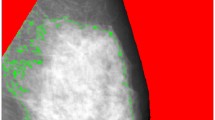The relationship of breast size both to breast cancer risk and to the laterality of the tumor was studied among 261 women diagnosed with breast cancer and 291 control subjects who were enrolled in the United States' Breast Cancer Detection and Demonstration Project from 1973 to 1980. Standardized measures of breast area were obtained by applying planimetry to bilateral screening mammograms taken four years before breast cancer was diagnosed in case subjects. The left breast was larger in 53 percent of women with breast cancer and in 60 percent of women in the control group; the difference in breast area by laterality was significant only among controls (P=0.01). To assess breast cancer risk, breast area was categorized by quartiles, with the lowest quartile being the referent group. Risk was increased minimally among women with the largest breast area (odds ratios = 0.9, 0.9, 1.2); however, the point estimates were not statistically significant and there was no evidence of a linear trend. Left-sided disease was diagnosed in 51 percent of women in the case group. Although the mean area of the breast with the malignancy did not differ significantly from the opposite breast, cancer developed in the larger breast of 57 percent of women with left- and 46 percent of women with right-sided disease. Breast size was associated with cancer of the left breast but not the right. However, these size differences were small since the area of the larger breast was less than 10 percent greater than the smaller breast among half of the case subjects. Further research is required to identify factors associated with the susceptibility of breast tissue to malignant transformation among women with unilateral disease.
Similar content being viewed by others
References
Catchpole BN. Breast size and cancer [Letter]. Br Med J 1977; i: 776.
Kolonel LN, Nomura AM, Lee J, Hirohata T. Anthropometric indicators of breast cancer risk in postmenopausal women in Hawaii. Nutrition & Cancer 1986; 8: 247–56.
Hsieh CC, Trichopoulos D. Breast size, handedness and breast cancer risk. Eur J Cancer 1991; 27: 131–5.
Dupont WD, Page DL. Breast cancer risk associated with proliferative disease, age at first birth and a family history of breast cancer. Am J Epidemiol 1987; 125: 769–79.
Wynder EL, Bross IJ, Hirayama T. A study of the epidemiology of cancer of the breast. Cancer 1960; 13: 559–601.
Katariya RN, Forrest APM, Gravelle IH. Breast volumes in cancer of the breast. Br J Cancer 1974; 29: 270–3.
Schaffer JP. Morris' Human Anatomy. Philadelphia, PA: Blakiston, 1953: 80–7.
Busk T, Clemmesen J. The frequencies of left- and right-sided breast cancer. Br J Cancer 1947; 1: 345–51.
Garfinkel L, Craig I, Seidman H. An appraisal of left and right breast cancer. JNCI 1959; 23: 617–31.
Senie RT, Rosen PP, Lesser ML, Snyder RE, Schottenfeld D, Duthie K. Epidemiology of breast carcinoma. II. Factors related to the predominance of left-sided disease. Cancer 1980; 46: 1705–13.
Saftlas AF, Hoover RN, Brinton LA, Szklo M, Olson DR, Wolfe JN. Mammographic densities as indicators of breast cancer risk. Cancer 1991; 67: 2833–8.
Wolfe JN, Saftlas AF, Salane M. Mammographic parenchymal patterns and quantitative evaluation of mammographic densities: a case-control study. Am J Radiol 1987; 148: 1087–92.
BMDP Statistical Software, Los Angeles, CA: BMDP, 1991.
Malini S, Smith EO, Goldzieher JW. Measurement of breast volume by ultrasound during menstrual cycles and with oral contraceptive use. Obstet Gynecol 1985; 66: 538–41.
Loughry CW, Sheffer DB, Price TE, et al. Breast volume measurement of 598 women using biosteriometric analysis. Ann Plast Surg 1989; 22: 380–5.
Milligan D, Drife JO, Short RV. Changes in breast volume during normal menstrual cycle and after oral contraceptives. Br Med J 1975; 11: 494–6.
Hytten FE. Clinical and chemical studies in human lactation: the functional capacity of the breast. Br Med J 1954; 1: 912–5.
Sasano N, Tateno H, Stemmermann GN. Volume and hyperplastic lesions of breasts of Japanese women in Hawaii and Japan. Prev Med 1978; 7: 196–204.
Campaigne BN, Katch VL, Freedson P, Sady S, Katch FI. Measurement of breast volume in females: description of a reliable method. Ann Hum Biol 1979; 6: 363–7.
Nassar AM, Smith RE. Menstrual variations in thermal properties of the human breast. J Appl Physiol 1975; 39: 806–11.
Smith DJ, Palin WE, Katch VL, Bennett JE. Breast volume and anthropometric measurements: normal values. Plast Reconstr Surg 1986; 78: 331–5.
Loughry CW, Sheffer DB, Price TE Jr, et al. Righ and left volume and volume distribution comparisons in normal and tumor-containing breasts. Cancer Det Prev 1987; 10: 215–21.
McManus IC. Predominance of left-sided breast tumors [Letter]. Lancet 1977; ii: 297–8.
Geschickter C. Diseases of the Breast, 2nd Ed. Philadelphia PA: Lippincott, 1945: 111–19.
MacBryde CM. The production of breast growth in the human female. JAMA 1939; 112: 1045–9.
Hartveit F. The side and size of breast tumours. Clin Oncol 1983; 9: 135–42.
Fowler PA, Casey CE, Cameron GG, Foster MA, Knight CH. Cyclic changes in composition and volume of the breast during the menstrual cycle, measured by magnetic resonance imaging. Br J Obstet Gynecol 1990; 97: 595–602.
Additional information
Dr Senie is with Memorial Sloan-Kettering Cancer Center, New York, NY, USA. Authors are also affiliated with the Centers for Disease Control and Prevention (Dr Saftlas), Atlanta, GA and the National Cancer Institute (Drs Brinton and Hoover), Bethesda, MD, USA. Address correspondence to Dr Senie, Breast Service, Department of Surgery, Memorial Sloan-Kettering Cancer Center, 1275 York Avenue, New York, New York, 10021, USA.
Rights and permissions
About this article
Cite this article
Senie, R.T., Saftlas, A.F., Brinton, L.A. et al. Is breast size a predictor of breast cancer risk or the laterality of the tumor?. Cancer Causes Control 4, 203–208 (1993). https://doi.org/10.1007/BF00051314
Received:
Accepted:
Issue Date:
DOI: https://doi.org/10.1007/BF00051314




